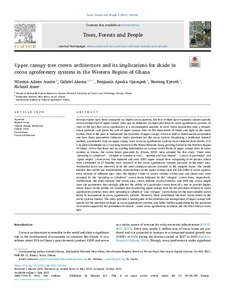| dc.contributor.author | Asante, W.A. |
| dc.contributor.author | Ahoma, G. |
| dc.contributor.author | Gyampoh, B. |
| dc.contributor.author | Kyereh, B. |
| dc.contributor.author | Asare, R. |
| dc.date.accessioned | 2021-07-09T12:49:18Z |
| dc.date.available | 2021-07-09T12:49:18Z |
| dc.date.issued | 2021-09 |
| dc.identifier.citation | Asante, W.A., Ahoma, G., Gyampoh, B., Kyereh, B. & Asare, R. (2021). Upper canopy tree crown architecture and its implications for shade in cocoa agroforestry systems in the western region of Ghana. Trees, Forests and People, 5:100100: 1-9. |
| dc.identifier.issn | 2666-7193 |
| dc.identifier.uri | https://hdl.handle.net/20.500.12478/7169 |
| dc.description.abstract | everal studies have been conducted on shaded cocoa systems, but few of these have examined species-specific crown architecture of upper canopy trees and its influence on shade provision in cocoa agroforestry systems. In view of the fact that cocoa agroforestry is a recommended practice to drive cocoa production onto a climate-smart pathway, and given the role of upper canopy trees in the moderation of shade and light to the cocoa system, there is the need to understand the dynamics of upper canopy crown as well as dendrometric parameters and how these parameters influence shade provision for the cocoa system. Employing a replicated transect method, quantitative data on upper canopy trees in cocoa agroforestry systems were collected from twelve (12) 1 ha plots established on a 5 km long transect at the Bonsu Nkwanta cocoa growing district in the Western Region of Ghana. Given that there was no existing information on various crown forms of upper canopy trees in cocoa systems in Ghana, the crown forms generated by (Frank, 2010) were adopted for this study. These were “spreading to cylindrical”, “elongate to rounded to oval”, “upswept and vase shaped”, “conical to pyramidal” and “spade shaped” crown forms. One hundred and sixty (160) upper canopy trees comprising of 44 species, which were distributed in 21 families were recorded in the cocoa agroforestry systems surveyed in the study area. Newbouldia laevis was observed to be the most abundant species recorded in the sampled farms. The results showed that crown and dendrometric characteristics of the upper canopy trees did not differ in cocoa agroforestry systems of different ages. Also, the highest values of crown volume, crown area and shade area were recorded by the “spreading to cylindrical” crown forms followed by the “elongate” crown form, respectively. Furthermore, the study showed that crown area, crown volume, crown diameter, tree DBH and crown height were the parameters that strongly affected the ability of a particular crown form of a tree to provide higher shade. Based on the results, we conclude that in selecting upper canopy trees for the provision of shade in cocoa agroforestry systems, trees with “spreading to cylindrical” and “elongate” crown forms are the most suitable crown forms to incorporate in cocoa agroforestry systems. However, these constituted the least crown forms in the cocoa systems studied. The study provides a useful guide to the selection and management of upper canopy tree species for the provision of shade in cocoa agroforestry systems, and holds further applications for the provision of decision support for the promotion of climate – smart cocoa agroforestry in Ghana and the West African cocoa belt. |
| dc.format.extent | 1-9 |
| dc.language.iso | en |
| dc.subject | Cocoa |
| dc.subject | Climate Change |
| dc.subject | Canopy Cover |
| dc.subject | Agroforestry |
| dc.subject | Ghana |
| dc.title | Upper canopy tree crown architecture and its implications for shade in cocoa agroforestry systems in the western region of Ghana |
| dc.type | Journal Article |
| cg.contributor.affiliation | Kwame Nkrumah University of Science and Technology |
| cg.contributor.affiliation | Solidaridad Network West Africa, Ghana |
| cg.contributor.affiliation | International Institute of Tropical Agriculture |
| cg.coverage.region | Africa |
| cg.coverage.region | West Africa |
| cg.coverage.country | Ghana |
| cg.coverage.hub | Headquarters and Western Africa Hub |
| cg.researchtheme | Natural Resource Management |
| cg.identifier.bibtexciteid | ASANTE:2021a |
| cg.isijournal | ISI Journal |
| cg.authorship.types | CGIAR and developing country institute |
| cg.iitasubject | Agronomy |
| cg.iitasubject | Climate Change |
| cg.iitasubject | Cocoa |
| cg.iitasubject | Forestry |
| cg.journal | Trees, Forests and People |
| cg.notes | Open Access Article; Published online: 01 Jun 2021 |
| cg.accessibilitystatus | Open Access |
| cg.reviewstatus | Peer Review |
| cg.usagerightslicense | Creative Commons Attribution-NonCommercial-NoDerivatives 4.0 (CC BY-NC-ND 4.0) |
| cg.targetaudience | Scientists |
| cg.identifier.doi | https://dx.doi.org/10.1016/j.tfp.2021.100100 |
| cg.iitaauthor.identifier | Richard Asare: 0000-0001-6798-7821 |
| cg.futureupdate.required | No |
| cg.identifier.issue | 100100 |
| cg.identifier.volume | 5 |

